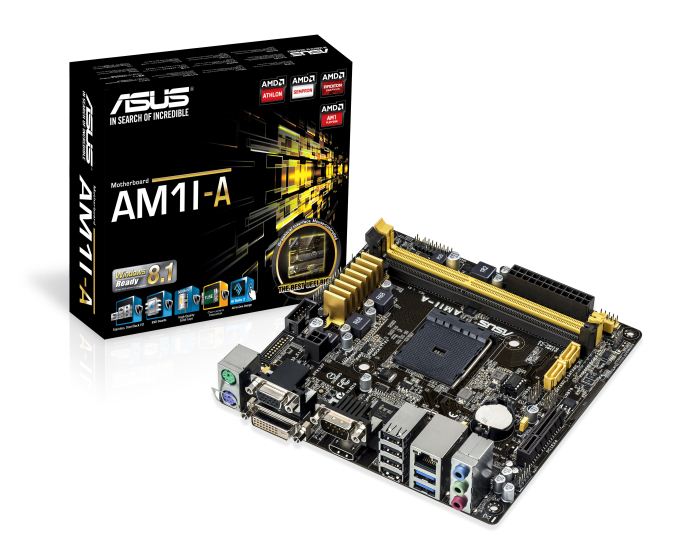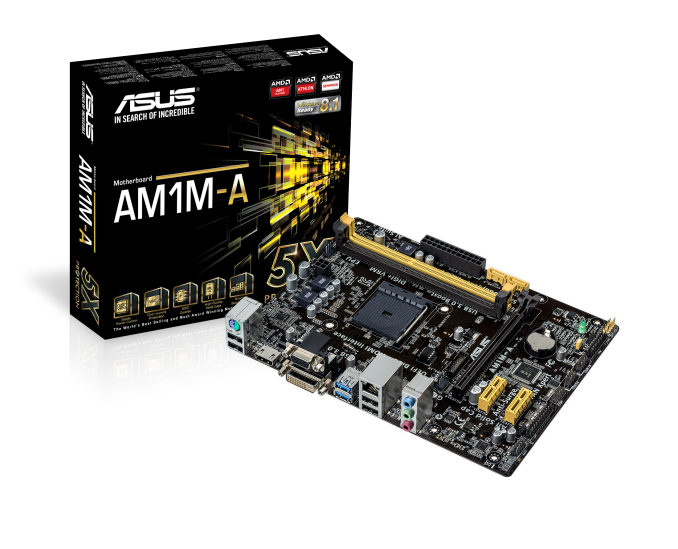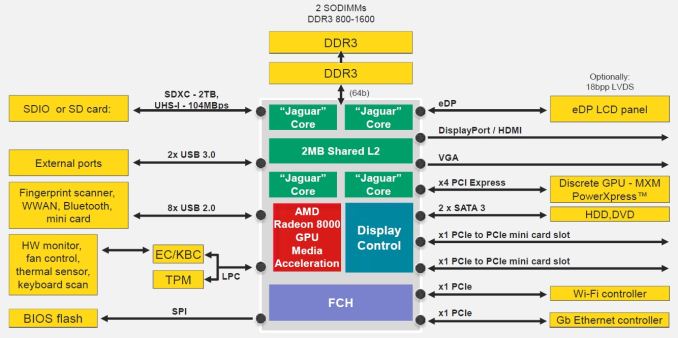ASUS’ AMD AM1 Approach: AM1I-A and AM1M-A Announced
by Ian Cutress on March 5, 2014 8:41 AM EST- Posted in
- Motherboards
- AMD
- Asus
- Kabini
- AM1

Hot on the heels of the AMD announcement regarding socketed Kabini systems, ASUS has released information on two of their main contenders in this segment. While AMD are expecting most motherboards to be in the micro-ATX form factor, at least a few mini-ITX will appear, and ASUS today are announcing at least one of each in the AM1I-A and AM1M-A.
AM1I-A
The mini-ITX model uses the FS1b socket (notice only two holes for a CPU cooler), with two DDR3-DIMM slots and two SATA 6 Gbps ports. The 4-pin CPU power connector is near the edge of the motherboard (to stop cables being passed over components), and similar to other ASUS mini-ITX motherboards the 24-pin ATX power connector is also on the edge. Although AMD’s initial AM1 announcement put the maximum DRAM capacity at 16GB, ASUS are claiming 32GB DRAM maximum capacity when 16GB UDIMMs are launched.
The motherboard uses Realtek Audio and NIC (ALC887 and 8111GR), with a PCIe 2.0 x4 slot, a HDMI output, a DVI-D output, two USB 3.0 ports, eight USB 2.0 ports (4 rear, 2 headers), a TPM header and two COM ports (1 rear, 1 header). ASUS features such as the graphical BIOS, DIGI+ VRM, USB 3.0 Boost and AI Suite 3 are also present.
AM1M-A
Using the larger micro-ATX form factor with a SoC that only has four PCIe 2.0 lanes might seem a little odd, but it does give the manufacturer space to add some other extra features, as well as cater for users that want more than one PCIe device. The main focus of the AM1M-A will be on the two PCIe 2.0 x1 slots below the PCIe 2.0 x4 slot. As the SoC is limited to four lanes, the way around this is to either use a switch, or selectively use one or the other. ASUS has gone for almost a mix, whereby the user can select the speed of the first black PCIe slot to x1, x2 or x4 accordingly.
The makeup of the AM1M-A is similar to the mini-ITX model – HDMI output, DVI-D output, VGA output, Realtek audio and NIC (ALC887-VD and 8111GR), two SATA 6 Gbps, four USB 3.0 ports (two rear, one header powered by an ASMedia controller), eight USB 2.0 ports (4 rear, 2 headers), a TPM header and a COM header. The AM1M-A also benefits from the ASUS graphical BIOS, USB 3.0 Boost, Fan Xpert, DIGI+ VRM and AI Suite 3.
With the use of a USB 3.0 controller onboard, there has to be some clever allocation of PCIe lanes to make it work. Chances are that the full length PCIe x16 slot runs at x4 when the two PCIe x1 slots and the internal USB 3.0 ports are not used. The moment one of them is in use, the full length slot becomes an x1 to release the bandwidth. The allocation would most likely happen at boot time, making the setting an option in the BIOS to enable or disable. I am asking ASUS which setting is default, though I would imagine the USB ports being enabled is the default setting to allow users to plug everything in. This means that if you need specifically a PCIe 2.0 x4, then it has to be enabled in the BIOS.
Using the chipset diagram for Kabini:
We see that the USB 3.0 controller is using one of the x1 PCIe lanes normally geared for the Wi-Fi controller. It would therefore look like that the PCIe 2.0 x4 and the two PCIe 2.0 x1 slots are also independent, such that the SoC actually has eight PCIe 2.0 lanes for use, but only as one set of four and four sets of one.
We are still unsure if AMD’s $60 price point is the ultra-low end objective of the AM1 platform (APU + motherboard) or the high end. Pricing from ASUS is TBD, but both boards should be available when the platform is launched on April 9th.













26 Comments
View All Comments
Fenton - Thursday, March 6, 2014 - link
"Underneath it's still a BIOS"Errrrm, the entire point of UEFI is that it ISN'T still the old legacy BIOS code underneath.
Congratulations on possibly your biggest train-wreck yet though, and completely rambling and inaccurate disaster of an article.
R3MF - Wednesday, March 5, 2014 - link
is solid caps rated for just "5000 hours" really a selling point?Metalliax - Wednesday, March 5, 2014 - link
R3MF: This means 5000 hours at 105deg Celsius. Check here for more info: http://event.asus.com/mb/5000hrs_VRM/TeXWiller - Wednesday, March 5, 2014 - link
Hopefully some quiet thermal solutions will be available for the socket.zhd - Wednesday, March 5, 2014 - link
whats with all this low power s**t? do people actually buy them? if you want mobile go for notebook or ultrabooks?For a long time, I am looking hardware sites, hoping for some advancement that in my interest. But all see, some mini itx, m-atx, smartphones and sh.t. Smartphones now have ips screens, full hd and even 1440p resoulutions. But if I want to buy a monitor at that res, I have to pay 600$. What the hell?
And AMD skips am3+ users or other users that demand high power desktop cpus and and releasing all these, useless things. What am I supposed to do with these? Screw mobility, screw power efficiency, I want damn power.
Its ok if you focus on apus, but just dont skip us. And now coin miners pulls gpu prices higher, I may do the thing I never thought I would do, and go intel-nvidia combo.
Drumsticks - Wednesday, March 5, 2014 - link
That's an awfully convoluted post of yours. This is for the developing market and has absolutely nothing to do with AMD's high power segment. They aren't even related development units - the development of this doesn't really affect the work on Kaveri/ future Excavator cores.Also, AMD isn't really responsible for the high GPU prices. And if you want power, you SHOULD be going Intel. Their CPUs are effectively unmatched when you need raw power in 80% of situations. AMD is improving but they still can't match Intel's high end. They do have a good value play now though.
You aren't supposed to do anything with this. It's not meant for you. Believe it or not, the world doesn't revolve around the 1% of technology enthusiasts like you, me, and plenty others on this site. You might say screw mobility, but that's where the money is headed.
Peroxyde - Wednesday, March 5, 2014 - link
Does this Kabini SoC has enough power to drive a custom NAS Server? I suppose I will need to add a PCIe SATA card to go above 2 drives? Would a regular AMD/Intel board with a low power CPU be a better alternative (to build a NAS)? Thanks in advance for any advice.crazysurfanz - Wednesday, March 5, 2014 - link
Good question, this is the kind of application I'm thinking of also. I'd also like to know whether inserting a device in the first PCIE slot affects the onboard graphics. (I had a board in the past that had onboard graphics, but as soon as you populated the x16 slot it got disabled (to be precise, the digital output, the vga output still worked at low res). It only had that one slot, so I couldn't populate it with a raid card, and use the onboard graphics - this was intended as a combo NAS/HTPC, so Full HD output was a requirement.Does anyone know if that same issue exists now that the GPU is part of the CPU? (interested in the answer for this and any other CPUs with built in GPU for that matter incl. Intel).
Bob Todd - Thursday, March 6, 2014 - link
I recently picked up a mITX Kabini (fanless SOC vareity) board dirt cheap with the intention of building my own AC router/IPS/etc. with Zentyal. I booted it with a x8 LSI SAS card attached just to make sure the slot worked. DVI and HDMI were fine with the card in. For the kinds of use cases being discussed, you can probably skip the socketed versions and go for an embedded option if they are cheaper. The one I bought is on sale repeatedly for around $32 AR.http://www.newegg.com/Product/Product.aspx?Item=N8...
I'd be a little worried about these having enough grunt for a NAS if you care about performance, but for ~$30 it's not like the experiment would cost you very much. I also think it's cool that these things aren't neutered badly on the CPU extension side (AES/AVX/etc.). There may be some very specific use cases where that would come in handy.
edzieba - Thursday, March 6, 2014 - link
In terms of CPU power it;s probably fine. But it looks like Kabini boards will not support ECC memory, which makes using it for a storage server a dicey proposal.